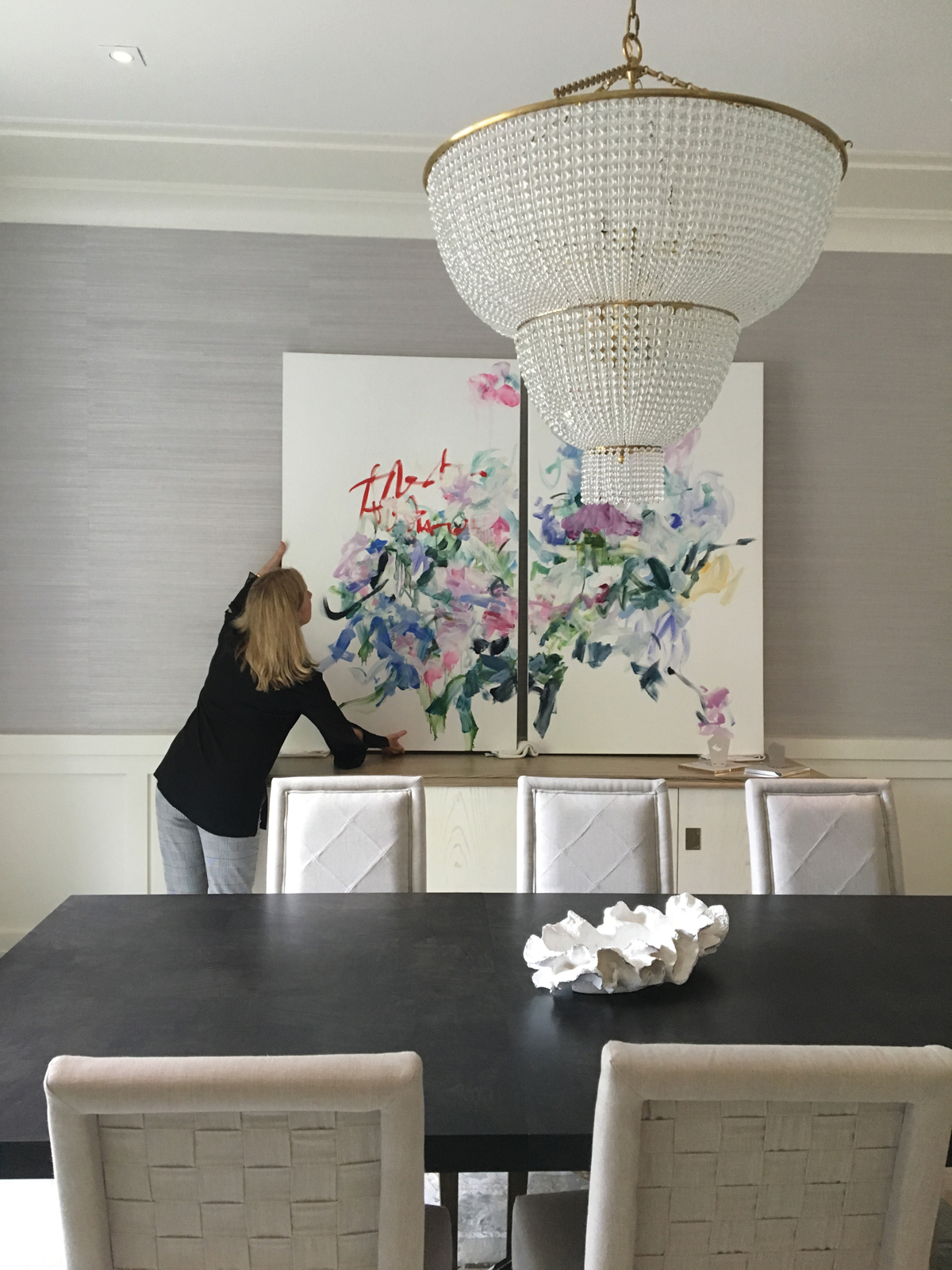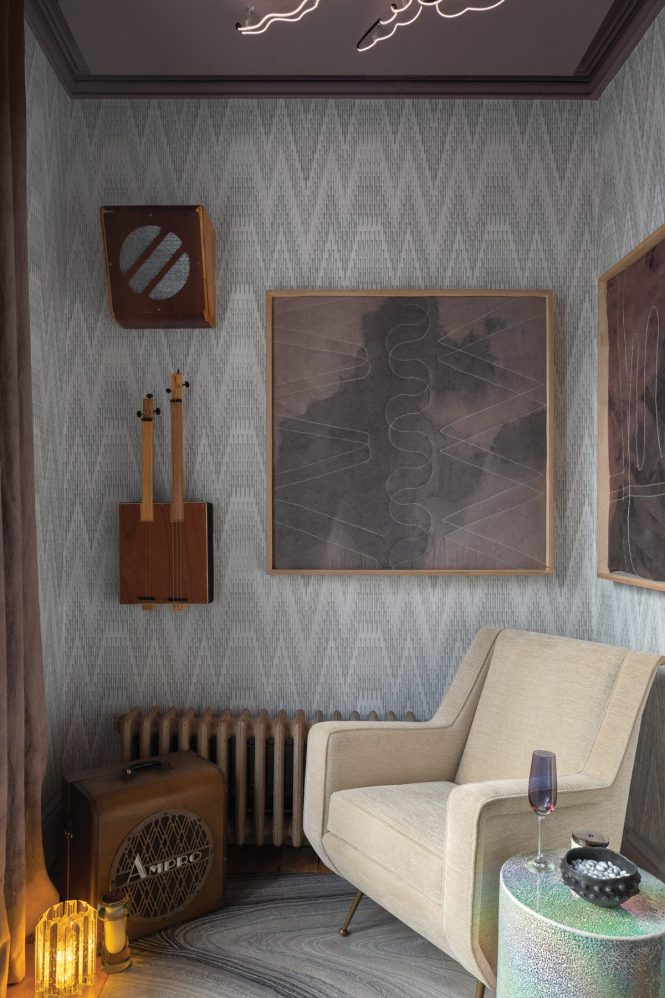Choosing Art for the Home
By Lisa Iannucci | Spring 2023 | Design Feature
David Rockefeller once said, “I think of art as the highest level of creativity. To me, it is one of the greatest sources of enjoyment.” Now, you might think that you need a Rockefeller-sized bank account to enjoy a great piece of art in your home, but think again.
“Literally anything can be art,” says Jennifer Salvemini, Principal of JLS Lifestyle Consulting in Shokan. “Art can be a found object or a memento from a vacation, whether it’s a postcard or a menu from a restaurant that you went to and that you loved. It doesn’t necessarily mean a framed canvas or photograph. It could be anything that is visually interesting, that brings you joy, or reminds you of something that has sentimental value, nostalgia, or however you want to define it.”
Molly McClarnon, administrative officer of Athens Fine Art Services in Hudson, says that once you can articulate why you like a piece, it is meant for you. “Have it reflect your personality and it will shine,” she says. “Trust your heart, buy what you like.”
Salvemini says that one of her favorite art pieces in her home is the cover of the India Times that she had delivered to her hotel room when she was traveling in India. “The cartoon on the cover has incredibly vivid, beautiful colors,” she says. “I carefully traveled with it for nine months. When I brought it home, I had it framed and every time I pass it, it reminds me of that trip and I really appreciate the imagery.”
Choose Art, Not Decor
Keep in mind, when you’re choosing art for your home, that it’s not the same as picking the room’s decor, Salvemini says. “I would buy a pillow to match a couch, but I would not buy a painting to match a wall,” she says. “When art is selected for a commercial space—a hotel or a restaurant—it is designed to be experienced very intentionally by customers. There’s something very specific that the restaurant or the hotel is trying to convey about its brand identity. It’s not personal.”
Art in the home, however, should be personal and reflect the person who lives there. “The art should be whatever that individual loves,” says Salvemini.

A space designed by Jennifer Salvemini for the 2020 Kingston Design Connection Showhouse, “The Listening Room,” featuring acoustic panels/wall art designed by Salvemini and produced in collaboration with Nancy Geaney and Nyamka Ayinde from the Hinterland Co-op, as well as found objects as art. Photo by Ariel Camilo
If your art needs to be framed, Salvemini suggests framing for the art, not the room. “That art will outlive you and the frame is the house of the art, so the art needs to live inside its own happy home,” she says.
Jen Dragon, director of Cross Contemporary Art Projects in Woodstock, says the wrong frame can actually eat at your artwork. “A cheap frame will not cut it if you’ve just spent $1,500 on a drawing or watercolor” she says. “The acid will eat the artwork and if it’s not well sealed in you’re going to get condensation and little brown spots will show up.”
But whether you choose a piece of pottery or a framed painting, where, oh where, should your art go in the room? Kenise Barnes, director of Kenise Barnes Fine Art in Kent, Connecticut, suggests first looking at the size of the space where the art is going to go and consider different options. “Art is the single most unique thing in your home,” says Barnes. “There is a lot to consider. Should you put one big painting up or a wall of several things hung salon style? Do you group two or three pieces by one artist or combine them with work by other artists? Or are you trying to integrate something into a collection you already have? When you think about hanging, you need to think about the specifics—what is the height, does it need to be lit, or is there any consideration to sunlight?”
For example, Barnes says if you have a big space over a fireplace, you need to decide if the art will hang vertically or horizontally. “How big will it be so it doesn’t overwhelm the room or feel too dinky for the space?” she says. “You have to get that balance.”
Dragon suggests that once you find that right piece of art, consider getting a professional installer to hang it for you. “I’ve been in many homes where the art is hung weirdly, and, once the person’s dissatisfied, they don’t feel happy with the art that they’ve got,” she says.
If you know you want a piece of art but don’t even know where to begin, Barnes suggests visiting a gallery or working with an advisor. “Tell them what your budget is,” she says. “Does it let you acquire one piece or four pieces? Spend some time talking to the dealer or art gallery owner, who can provide you with lots of information about how the work is made and the biography of the artists you’re interested in.”

A Portia Munson artwork on silk called, Owl, being installed over a fireplace in a private home in Saugerties.
But what if there is a piece of artwork that you’re interested in and the price tag is a bit daunting? “It can be expensive,” says Dragon. “A large painting by a mid-career artist is often $5,000. And that’s the problem. People can’t necessarily write a $5,000 check to buy art.”
Instead, Dragon recommends a tool called Art Money that helps buyers purchase art and pay for it over time. “It charges no interest to the buyer but how much credit you get is based on your income,” she explains. “It helps buyers afford to own art. It’s a game changer. Older people don’t necessarily want to buy anything because they’ve spent a lifetime of collecting. Those in their 30s and 40s are buying a new home and setting up their environment and want to buy art, so there has to be creative ways for people to be able to finance things.”
No matter the space you are looking to fill or the budget that you have, all of our experts agree on one thing—the most important aspect to hanging art in your home is the response that you—not your guests—have to it.
“Some people see something and don’t know why they like it, but you should find the artwork that inspires you to do what you want to do with your life,” says Dragon. “For example, you’ve always had a dream about writing a screenplay or a poem or even making a painting yourself. The artwork should be the thing that reminds you what it is that you really want to do with your life.”
